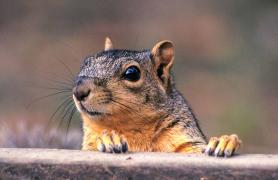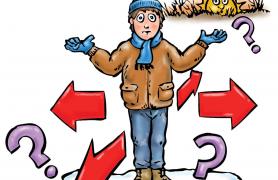Into the Wild: Cypress Swamp
The Bootheel’s cypress swamps are home to some of Missouri’s most amazing plants and animals. Pull on your rubber boots, and let’s wade in!
What Happened Here?
If you find what look like raisins on a log, Don’t Eat Them! Swamp rabbits often jump in the water to escape predators. They rest on stumps and logs, leaving behind raisinlike scat.
Look
Most ducks migrate through Missouri in spring and fall, but hooded mergansers hang out in Bootheel swamps all year. The duck is easy to identify by the large crest on its head. Males have black-and-white crests. Females have reddish-brown crests.
Did You Know?
The alligator gar is one of North America’s largest freshwater fishes. Named for its toothy smile and alligator like snout, this freaky fish has been known to grow longer than your sofa and weigh more than 300 pounds!
Take a Closer Look
These floating green specks are duckweed, Missouri’s tiniest flowering plants. Under the right conditions, duckweeds can double in number in less than three days. As its name suggests, ducks (and lots of other animals) eat duckweed.
Did You Know?
Lesser sirens look like eels, but they’re actually amphibians. If the swamp dries out, the siren burrows into the mud. Thick slime on its skin hardens to form a shell around its body. The shell keeps the siren from drying out, allowing it to survive for weeks without water.
Heads Up!
Swamps grow a healthy crop of mosquitoes. Be sure to wear bug spray.
Smell
A handful of swamp muck contains billions of bacteria and other microscopic organisms. Some of these teeny-tiny creatures break down dead plants and animals. As they do, they release gases that smell like rotten eggs. Pee-yoo!
Listen
With leaf-green skin, green treefrogs are easier to hear than see. The 2-inch-long frogs sound like a Canada goose honking: ronk, ronk, ronk. They call loudest during rainy weather, which is why some people call them rain frogs.
Look
Bald cypress trees have bumpy stumps that stick out of the water. The stumps, called “knees,” act like snorkels to carry air down to the tree’s roots.
Look
Double-crested cormorants produce less oil than other water birds. So when they dive for fish, their feathers get soaked. Look for cormorants standing on stumps, holding their waterlogged wings out to dry.
Also In This Issue


And More...
This Issue's Staff
Les Fortenberry
Karen Hudson
Angie Daly Morfeld
Noppadol Paothong
Marci Porter
Mark Raithel
Laura Scheuler
Matt Seek
David Stonner
Nichole LeClair Terrill
Stephanie Thurber
Cliff White






















